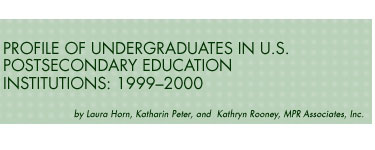

 |
 |
 |
||||||||||||
|
|
 |
|||||||||||||
|
Among Hispanic undergraduates, Mexican, Mexican American, or Chicano students made up the largest group (55 percent versus 4 to 27 percent for other Hispanic groups). Among Asian undergraduates, Chinese students made up the largest group (25 percent versus 3 to 13 percent for other Asian groups). While a majority of undergraduates were younger than 24, about one in four were 30 or older. The average age of undergraduates was 26 and the median age was 22. About 7 percent of undergraduates were not U.S. citizens. Of these noncitizens, 5 percent were permanent residents, and 2 percent were foreign students. Undergraduates who were born in another country, immigrated to the United States, and became citizens comprised 4 percent of undergraduates. One in ten undergraduates were born in the United States but had at least one foreign-born parent. In addition, 13 percent of undergraduates spoke a language other than English in the home while growing up. Students who were parents made up 27 percent of undergraduates,2 including 13 percent who were single parents.3 While women were more likely to be single parents (16 percent), 9 percent of unmarried men also reported having dependents. When asked to report on a series of disabling conditions or difficulties with basic physical activities, 9 percent of undergraduates reported having some such condition or difficulty.4 However, when asked specifically, "Do you consider yourself to have a disability?" the proportion who responded "yes" was considerably lower (4 percent). |
||||||||||||||